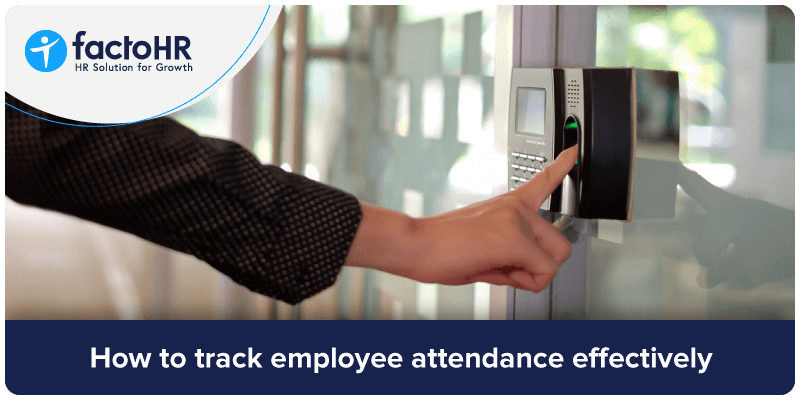How to Track Employee Attendance Effectively

Table of Contents
There are several ways to track employee attendance including the old-fashioned physical paper register book for employees to sign in and out. With advancements in artificial intelligence and machine learning technologies, smart ways are becoming the only way to effectively manage employee attendance. The key word here is “effectively”, meaning the working hours of every employee are captured accurately with minimal or no manual intervention and time spent on that activity. This captured attendance data should feed into other systems like payroll and leave management without any additional effort. With employees preferring to work from home or remotely, AI is no longer a luxury but a necessity for effective monitoring of their work hours.

What Comprises Effective Attendance Tracking?
Tracking attendance manually is cumbersome and error-prone. Consider automating your attendance management with an online attendance management system with the below technologies built-in to automatically capture employee attendance.
Facial Recognition
Using a camera to scan an employee’s face and matching it with their ID in a database is how the employee is identified. This is done either through a computer or a mobile device and can be integrated with existing systems such as HR and payroll management software to provide accurate and real-time attendance data. Using AI-powered facial recognition technology, attendance can be automatically taken as employees walk in and out of the office. Advanced AI-based facial recognition optimizes your attendance marking with “liveliness” detection. Employees can register their faces as part of the app onboarding. The system is clever enough to detect falsification attempts like a prerecorded picture or video of the person. It uses facial proportions and geometricity to match a registered face.
Geo-Fencing
Geofencing technology uses GPS coordinates to track an employee’s location and ensure they are within a certain area or “geofence” during work hours. Optimize your attendance management system with geofencing and place virtual boundaries around particular locations where the employees are planning to work from – it could be home, office, or a different location for a visit to the client. This virtual boundary will allow employees to punch in only within it using a mobile app. Any attempts to punch in from outside the geo-fenced area will not be recorded.
Mobile App
Employees can use mobile apps to check in and out. This technology uses two pieces of data to corroborate accuracy. This allows your employees to mark attendance in a secured mechanism from their mobile applications that is authenticated using their selfie picture and GPS location from the mobile phone. The photo is compared against the database to identify the employee. The GPS coordinates help in identifying that the employee is actually in the designated location. This method can be used even when employees are working from the office and eliminate the need for physical biometric devices to be installed at office premises.
Many of these methods also depend on other external technologies like GPS and mobile data to work. There is always an option for supervisors to punch in for their direct reports, in cases where such difficulties arise.

Why do Companies Need to Track Attendance Effectively?
Effective tracking of employee attendance is critical for companies, as it helps in:
Compliance with Laws
Many counties have laws regulating minimum wage and overtime due to the employees. By keeping verifiable and accurate records of employee attendance, companies can use them to demonstrate compliance with regulations. Accurate attendance records could also be used as evidence in the event of any disputes.
Payroll
The payroll system uses employee attendance and leave records to accurately calculate the pay. Any ineffective tracking of attendance records may lead to inaccurate calculations. Employers need to know how many hours employees have worked in order to calculate their pay, and also for compliance with laws requiring payment for overtime.
Scheduling
Knowing which employees are available and when is important for scheduling shifts and ensuring adequate coverage.
Productivity
Productivity metrics take into account the number of hours worked and the quantity and quality of output produced by the employees. Effective metrics can only be possible if the attendance and leave records are accurate. Any trends indicating frequent absenteeism or less number of hours worked frequently could indicate issues employees may be facing. The productivity issues could be a result of a lack of specific skill training or personal issues. Employers can help the employees if they effectively track booth attendance and productivity.
Planning
Historical data is usually used to predict future trends. The more accurate the data, the more accurate predictions are too. When companies have accurate attendance and productivity metrics, planning for future activities becomes easier. Companies can identify skill gaps and train employees who require additional help. Planning for resource requirements too will become more accurate helping the company to be efficient and effective.
Compliance with Company Policies
While companies are willing to be flexible in terms of working location and specific time of the day, they still need to have their employees to conform to the company policies around the total number of days and hours worked. Accurate attendance records can help in case of any disputes arising due to absenteeism or non-punctuality in delivering outcomes.

Conclusion
When you are ready and looking for an effective solution for attendance tracking, consider the end-to-end process, the quality of data that is collected, and how well the new software integrates with existing HR systems that use attendance data.
Grow your business with factoHR today
Focus on the significant decision-making tasks, transfer all your common repetitive HR tasks to factoHR and see the things falling into their place.

© 2026 Copyright factoHR


